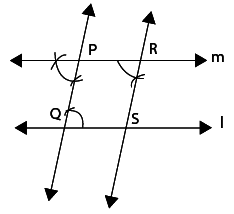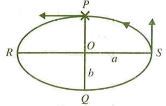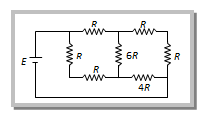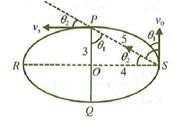12th Grade > Physics
SOUND MCQs
Total Questions : 31
| Page 3 of 4 pages
Answer: Option A. -> 30 m/s
:
A
Apparent Frequency is given by:
n′=n(v+v0v−vs)
605=550(330+0330−vs)
vs=30m/s
:
A
Apparent Frequency is given by:
n′=n(v+v0v−vs)
605=550(330+0330−vs)
vs=30m/s
Question 22. A source of sound S is moving with a velocity 50 m/s towards a stationary observer. He measures the frequency of the source as 1000 Hz. What will be the apparent frequency of the sound when it is moving away from the observer after crossing him? The velocity of the sound in the medium is 350 m/s.
Answer: Option A. -> 750 Hz
:
A
When the source is coming to stationary observer,n′=(vv−vs)n
or n=(1000×300350)Hz
When the source is moving away from the stationary observer,
n"=(vv+vs)n=(350350+50)(1000×300350)=750Hz
:
A
When the source is coming to stationary observer,n′=(vv−vs)n
or n=(1000×300350)Hz
When the source is moving away from the stationary observer,
n"=(vv+vs)n=(350350+50)(1000×300350)=750Hz
Answer: Option C. -> 2vb(v+vm)v2−v2bf
:
C
The motorist receives two sound waves: direct one and that reflected from the wall.
f′=v+vmv+vbf
For reflected sound waves:
Frequency of sound wave reflected from the wall is
f"=vv−vb×f

Frequency of the reflected waves as received by the moving motorist is
f′"=v+vbv−vb×f′−v+vmv+vbf
Therefore, the beat frequency is
f′"=v+vmv−vb×f−v+vmv+vbf
=2vb(v+vm)v2−v2bf
:
C
The motorist receives two sound waves: direct one and that reflected from the wall.
f′=v+vmv+vbf
For reflected sound waves:
Frequency of sound wave reflected from the wall is
f"=vv−vb×f

Frequency of the reflected waves as received by the moving motorist is
f′"=v+vbv−vb×f′−v+vmv+vbf
Therefore, the beat frequency is
f′"=v+vmv−vb×f−v+vmv+vbf
=2vb(v+vm)v2−v2bf
Answer: Option C. -> v+uv−uf
:
C
Apparent frequency for reflector (which will act here as an observer) would be f1=(v+uv)fWhere f is the actual frequency of source. The reflector will now behave as a source. The apparent frequency will now become
f2=(vv−u)f1
Substituting the value of f1we get
f2=(v+uv−u)f
:
C
Apparent frequency for reflector (which will act here as an observer) would be f1=(v+uv)fWhere f is the actual frequency of source. The reflector will now behave as a source. The apparent frequency will now become
f2=(vv−u)f1
Substituting the value of f1we get
f2=(v+uv−u)f
Question 25. The sound from a very high burst of fireworks takes 5 s to arrive at the observer. The burst occurs 1662 m above the observer and travels vertically through two stratifier layers of air, the top one of thickness
d1 at 0∘C and the bottom one of thickness d2 at 20∘C. Then (assume velocity of sound at 0∘C is 330 m/s)
d1 at 0∘C and the bottom one of thickness d2 at 20∘C. Then (assume velocity of sound at 0∘C is 330 m/s)
Answer: Option D. -> d2=342m
:
D
Time taken is given by
T=t1+t2=d1v1+d2v2V1=v∘0c=330m/sv2=(330+.06t)=342m/sd=1662m∴T=d1330+(d−d1)342=5sd1(342−330)330×342+d342=5s12d1=5(342×330)−330×1662d1=1320md2=342m
:
D
Time taken is given by
T=t1+t2=d1v1+d2v2V1=v∘0c=330m/sv2=(330+.06t)=342m/sd=1662m∴T=d1330+(d−d1)342=5sd1(342−330)330×342+d342=5s12d1=5(342×330)−330×1662d1=1320md2=342m
Answer: Option D. -> 10%
:
D
When the source approaches the observer,
f1=f(vv−vs)=f(1−vsv)−1≈f(1+vsv)or(f1−ff)×100=vsv×100=10.........(1)
In the second case, when the source recedes from the observer
f2=f(vv+vs)=f(1+vsv)−1=f(1−vsv)∴(f2−ff)×100=−vsv×100=−10
[from Eq.(i)]
In the first case, observed frequency increases by 10% while in the second case, observed frequency decreases by 10%
:
D
When the source approaches the observer,
f1=f(vv−vs)=f(1−vsv)−1≈f(1+vsv)or(f1−ff)×100=vsv×100=10.........(1)
In the second case, when the source recedes from the observer
f2=f(vv+vs)=f(1+vsv)−1=f(1−vsv)∴(f2−ff)×100=−vsv×100=−10
[from Eq.(i)]
In the first case, observed frequency increases by 10% while in the second case, observed frequency decreases by 10%
Answer: Option D. -> 10%
:
D
ξ=Asin(kx−ωt)Pex=−Bdξdx=−BAkcos(kx−ωt)AmplitudeofPexisBAk=(5×105)(10−4)(2π0.2)=5π×102Pa
:
D
ξ=Asin(kx−ωt)Pex=−Bdξdx=−BAkcos(kx−ωt)AmplitudeofPexisBAk=(5×105)(10−4)(2π0.2)=5π×102Pa
Question 28. In the figure shown, a source of sound of frequency 510 Hz moves with constant velocity = 20 m/s in the direction shown. The wind is blowing at a constant velocity = 20 m/s towards an observer who is at rest at point B. Corresponding to the sound emitted by the source at initial position A, the frequency detected by the observer is equal to (speed of sound relative to air is 330 m/s)
Answer: Option C. -> 525 Hz
:
C
Apparent frequency is given by n′=n(u+vw)(u+vw−vscos60∘) =510(330+20)330+20−20cos60∘ =510×350340=525Hz
:
C
Apparent frequency is given by n′=n(u+vw)(u+vw−vscos60∘) =510(330+20)330+20−20cos60∘ =510×350340=525Hz
Answer: Option A. -> 9:11
:
A
Wavelength of the incident sound is
λl=10u−u2f=19u2f
Frequency of the incident sound is
Fi=10u−u10u−u2f=1819f=fr
When fr is the frequency of the reflected sound. Wavelength of the reflected sound is
λr=10u+ufr=11u18f×19=11×1918uf
∴λiλr=19u2f×18f11×19u=911
:
A
Wavelength of the incident sound is
λl=10u−u2f=19u2f
Frequency of the incident sound is
Fi=10u−u10u−u2f=1819f=fr
When fr is the frequency of the reflected sound. Wavelength of the reflected sound is
λr=10u+ufr=11u18f×19=11×1918uf
∴λiλr=19u2f×18f11×19u=911
Question 30. A train is moving in an elliptical orbit in anticlockwise sense with a speed of 110 m/s. Guard is also moving in the given direction with same speed as that of train. The ratio of the length of major and minor axes is 43. Driver blows a whistle of 1900 Hz at P, which is received by guard at S. The frequency received by guard is (velocity of sound v = 330 m/s)





















